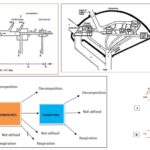Describe that a double circulation provides a low pressure circulation to the lungs and a high pressure circulation to the body tissues
Describe that a double circulation provides a low pressure circulation to the lungs and a high pressure circulation to the body tissues
Please login to submit an answer.
Double circulation is a vital component of the cardiovascular system in mammals and birds, characterized by two distinct pathways: pulmonary circulation and systemic circulation. This system provides a low-pressure circulation to the lungs and a high-pressure circulation to the body tissues, each serving specific physiological functions.
Low-Pressure Circulation to the Lungs
In double circulation, pulmonary circulation refers to the pathway through which deoxygenated blood is transported from the heart to the lungs. The key features of this low-pressure system include:
- Pressure Levels: The pressure in the pulmonary arteries is significantly lower than that in systemic arteries. For instance, the right ventricle pumps blood at a systolic pressure of approximately 25 mmHg into the pulmonary artery, which then branches into smaller vessels and capillaries within the lungs. This low pressure (around 8 mmHg in pulmonary arteries) is crucial for preventing damage to delicate lung tissues and facilitating efficient gas exchange.
- Gas Exchange Efficiency: The low-pressure environment in the pulmonary capillaries allows for optimal gas exchange. Oxygen can easily diffuse into the blood while carbon dioxide diffuses out, thanks to the thin walls of the capillaries and alveoli. High pressure would risk rupturing these fragile structures and impairing gas exchange.
- Vascular Compliance: The pulmonary vessels are highly compliant, meaning they can expand to accommodate increased blood flow during activities such as exercise without a significant rise in pressure. This adaptability helps maintain effective gas exchange even with varying levels of physical activity.
High-Pressure Circulation to Body Tissues
In contrast, systemic circulation refers to the pathway that delivers oxygenated blood from the heart to all body tissues. This system operates under higher pressure for several reasons:
- Pressure Levels: The left ventricle pumps oxygenated blood into the aorta at a much higher pressure (around 120 mmHg) compared to pulmonary circulation. This high pressure is necessary to propel blood through extensive networks of arteries, arterioles, and capillaries throughout the body.
- Efficient Nutrient Delivery: The high-pressure system ensures that oxygen and nutrients are delivered efficiently to tissues that require them for metabolism. It also facilitates the removal of waste products like carbon dioxide from tissues back to the heart.
- Adaptation to Metabolic Demand: Systemic circulation can adjust its pressure based on physiological needs. During exercise or increased metabolic activity, systemic vascular resistance can decrease, allowing for greater blood flow and oxygen delivery without compromising pressure levels
- Share on Facebook
- Share on Twitter
- Share on LinkedIn
Helpful: 0%




